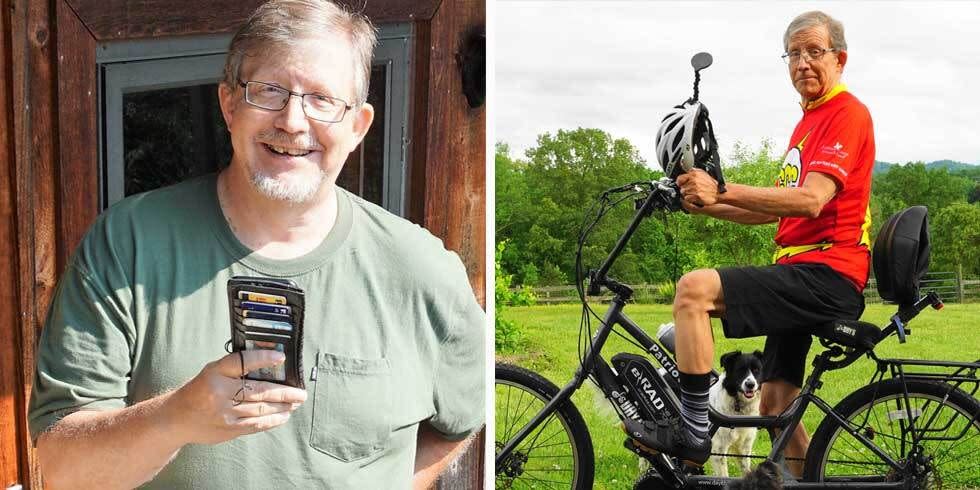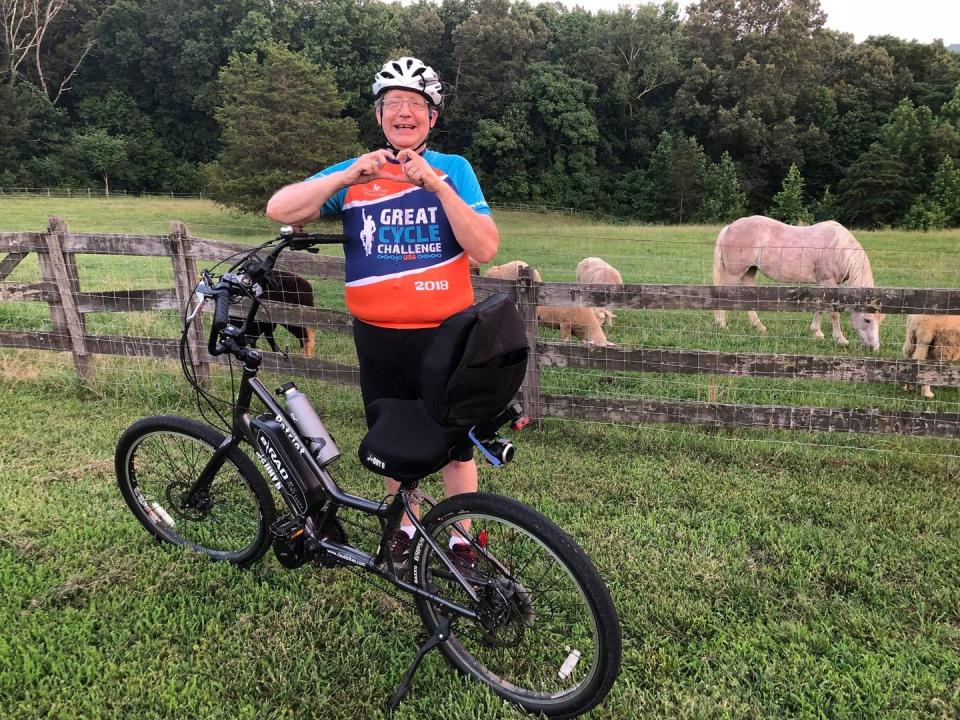An E-Bike Helped This Cyclist Drop 105 Pounds and Kick Diabetes

Age: 63
Occupation: Medical device software developer
Hometown: Knoxville, Tennessee
Start Weight: 270 pounds
End Weight: 165 pounds
Time Cycling: 3 years (after a 30-year hiatus)
I loved to ride when I was younger and living in Madison, Wisconsin, for graduate school. Madison has always been a very bike-friendly town, and I would bike 40 minutes to campus and back.
When I graduated, I got a job outside of Chicago and didn’t ride my bike for the next 30 years. Instead, I pursued my career of leading software development for medical devices for cancer diagnosis and treatment, which brought me to Knoxville.
That time not exercising and spent eating from vending machines took its toll, and in 2004 I was diagnosed with type 2 diabetes. My physician put me on Metformin for blood glucose control, Benazepril for kidney protection, and a statin (cholesterol-lowering medication) for my cardiovascular health.
I took the diagnosis seriously. I lost 30 pounds mostly by watching my food portions and brought down my hemoglobin A1C, a number that indicates my long-term blood sugar levels, but I still hovered in the overweight BMI category.
Soon after, I took a new job, and history repeated itself, as I stopped paying attention to my diet. In September 2017, my hemoglobin A1c was 7.2, still in the diabetic range, and I weighed 270 pounds. I thought, “Oh, my heavens, this has got to stop.”
I needed to do something different, and I remembered how much joy biking brought me back when I lived in Madison. So I went to the web and Googled “bicycles for overweight old men with bad backs.” I had facet joint arthritis (a spine condition), and I’m sure the weight wasn’t helping.
The one that stood out was the Day6 Patriot, which was made by a company in Iowa that specialized in products for people with mobility issues. It had a wide seat, lumbar support, and a pedal forward design, so you can put both feet on the ground when seated. It was also capable of taking a 300-pound payload. I test-rode a non-electric version at West Bicycles here in Knoxville, but the road to my home has an extremely steep grade, which made an e-bike a more effective choice.
I decided to make an investment in my health. It wasn’t a trivial cost—$3,300—but I wanted to get on a bike again.
The electric bike gave me confidence to climb the hills to get home on a long ride and to keep up on a group ride. It also gave me flexibility to dial up the effort. I could go from a joy ride to a genuine effort.
[Want to fly up hills? Climb! gives you the workouts and mental strategies to conquer your nearest peak.]
On November 4, 2017, I set out on my first ride. I rolled right out of my home in north Knox County and charted my route using the MapMyRide app. My first ride was approximately 9 miles with an elevation gain of 764 feet at a recreational pace of 11.9 mph.
I was able to take advantage of Knoxville’s parks and greenways, and I used the Strava app to record my rides and track my progress against myself and others. It was encouraging to register personal bests as a measure of improvement. As I started riding at a brisker pace, I switched to the “E-Bike” sport category on Strava to be fair to unassisted cyclists.
On March 31, 2018, five months into my journey, I reached a milestone of 1,000 miles. I was riding primarily from home with a typical distance of 30 miles and an elevation gain of 2,000 feet at a brisker pace of 15.6 mph.
That June I spent the month doing the Great Cycle Challenge for the Children’s Cancer Research Fund and over the course of the month logged 700 miles and raised $2,000, exceeding what I thought were “stretch” goals of riding 400 miles and raising $500.

By the end of that month, I had lost 44 pounds, now weighing 226 pounds and had a HbA1c of 6.6—almost back into prediabetic range. I was disappointed that I hadn’t lowered my blood glucose more. I knew I had to do something about my diet.
My wife and daughter were also seeking to lose some weight, so we started intermittent fasting, which limited our eating to a period of eight hours a day.
In August we reduced carbohydrates and replaced them with fat. What had been a steady one pound a week weight loss increased to two pounds a week.
On my low-carb, high-fat diet the rules are simple: One, prioritize macronutrients with fat first, then protein, and carbs (about 40 grams or less). Two, eat real food. For example, I’ll eat three eggs and bacon for breakfast and enjoy a green salad with olive oil, avocados, and sardines or salmon for lunch. Meals like that are naturally satisfying and limit my insulin response.
By the end of August, I had moved my BMI from overweight to normal, which I considered a bit of a pipe dream when I began.
That summer my wife Kathy also made the decision to join me, so we ordered the same bike for her as our 26th anniversary gift. We rented a cottage on the Natchez Trace Parkway, so she’d have a flat, quiet place to learn, and within an hour she was rolling like a champ. Now we share the joy of riding together and join group rides with bike shops and clubs.
When I was first told I had diabetes, it was a bit unsettling. I thought it was a progressive disease you can only manage through medication. I had a physical just after Christmas, 13 months and 3,300 miles into my journey. I’d reached 184 pounds, my blood pressure was 116/70, and my HbA1c was 4.9, low enough to come off medication.
I also added high intensity interval training into my program, doing sprints on the stationary bike at the gym, which is a good complement to the aerobic work I get on my e-bike.
I’m 165 pounds now, which is what I weighed in high school. When I was 270 pounds, I thought I’d maybe get to 220 and be fine. But I had no idea how easy this kind of eating is or how great I’d feel. I just kept going. I never thought I could weigh what I did in high school again. Now I do.
A coronary artery calcium scan showed that all those years of high blood sugar did damage to my arteries. So I am following an aggressive lipid lowering regimen to reverse this. But I feel great. Cycling is so great for your mood, joints, and health. It’s such a tonic every time I’m out on the road.
I want to motivate people by showing them an enjoyable sustainable pathway to change for which the e-bike is a catalyst and remains a key component. If we can replicate my experiment of one, we can, person by person, make a real change in our obesity and diabetes epidemic.
You can follow Treffert’s journey here.
We want to hear how cycling changed you! Send your story and submit your photos to us via this web form. We’ll pick one each week to highlight on the site.
You Might Also Like

